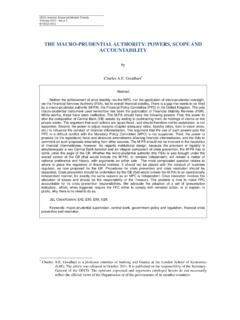Transcription of Eva Srejber: Growth and competition - lessons from the ...
1 Eva srejber : Growth and competition - lessons from the past Speech by Ms Eva srejber , First Deputy Governor of the Sveriges Riksbank, at Sparbanken Gripen, B stad, 25 August 2003. * * *. Thank you for the invitation to come here and speak on the occasion of Sparbanken Gripen's 150th anniversary. In my speech today, I intend to attempt to draw some conclusions from the experiences of our economic history during this period. One of my conclusions is that Swedish Growth has been stimulated during the periods when we have allowed the market economy to operate under clear and fixed game rules, including a stable framework for both fiscal policy and monetary policy. If these conditions have not existed, we have paid a price in the form of weaker economic Growth . This speech does not contain any signals regarding current monetary policy. The past 150 years have been an exciting time, in particular the first part of this period.
2 This was when Sweden changed from being a remote, developing country with a high infant mortality rate, widespread poverty and starvation, into a prominent industrial nation. Around 1850 Sweden entered into a dynamic period of rapid development and change. A wave of liberalisation swept across the country and opened up important markets. GDP Growth amounted to more than 2 per cent a year, which was twice as high as the Growth rate during the first half of the 19th century. A doubling of the GDP Growth rate might not sound particularly exciting, but over time it has very major effects. An increase in the GDP Growth rate from one to two per cent entails the standard of living doubling within 35 years instead of 70 years. For Sweden the stronger Growth rate during the second half of the 19th century meant that we emerged from the developing country stage. A number of factors contributed to this development.
3 Free trade was an important element. Our exports abroad were central to this process, which was of course facilitated by the development of the railway system. During the first decades after 1850, there were three main export products contributing to a very rapid export upturn; oats, iron and timber. The importance of exports of oats from the southern part of Sweden is something of a curiosity. Oats were the fuel of that time. All of the horses providing transport in industrial cities like London required oats and much of this came from G taland. The construction of the railway, as well as investment in industry, housing construction and agriculture naturally required capital. This was mainly obtained from abroad. Sweden was a typical example of a country with an expansionary economy making use of saving in other parts of Europe. This borrowing from abroad was on a very large scale and, prior to the outbreak of the First World War, Sweden was probably the most indebted nation of the time.
4 High level of international mobility If one looks at this period in diagram form , it is quite striking how much Growth varied, even if a five- year sliding average is used. The fluctuations in economic activity were considerable and this of course put households in a vulnerable position, as there was broadly speaking no social welfare system at that time. Although living conditions improved rapidly, they were still insufficient for many people. There was extensive emigration. However, a large number of these emigrants returned to Sweden and we had a widespread interchange with other countries. There were very few limitations to international mobility for people, capital, products and ideas. If we instead look at price developments, we can observe average low rates of price increase around 2 per cent a year during this time, and during the period as whole. However, there are also substantial variations.
5 There were general price falls - deflation - on a number of occasions. Deflation is normally associated with very large shocks such as those during the 1930s depression in the USA and Germany, but at the end of the 19th century, there were also price falls in Sweden during an otherwise favourable economic climate. One important explanation for this is that deflation is not necessarily caused by weak demand in the economy. Rapid productivity Growth can also generate a price fall and this was what occurred periodically during the second half of the 19th century. In these situations deflation need not be the bugbear to economic development that it is often made out to be. On the other hand, if we move forward a few years to the period during and after the First World War, we do see large shocks - falling GDP combined with very high inflation, followed by severe deflation at BIS Review 37/2003 1.
6 The beginning of the 1920s. This was when Sweden experienced its most severe economic crisis, rather than during the 1930s as was the case in the USA and Germany, for instance. If we move forward to the post-war period, this was a unique time of high and constant Growth . During the period following the Second World War and up to the 1970s, standards of living rose at a record rate throughout the world. An interesting fact is that although Growth in Sweden during this period was higher than it had been at any other time, it was nevertheless rather low in an international comparison. Many European countries, including our Scandinavian neighbours, grew at an even more rapid rate. However, from the 1970s the problems increased. Growth waned and inflation rose. We managed to temporarily stimulate Growth by means of substantial devaluations, but there was no proper follow-up and the economy overheated, only to turn around entirely at the beginning of the 1990s, resulting in extensive problems for the financial sector.
7 Since then we have had a decade or so with better Growth and more balanced developments. The average Growth rate during these years was just over 3 per cent. This was very different from the average Growth we had during the previous ten years. During the transition phase between these periods a number of important changes were implemented regarding the allocation of resources in society. Here I am referring to the deregulation of the financial markets, reforms in the pension, tax and social insurance systems and a reduction in the burden of taxation. In addition, wage formation has been improved, which has probably been facilitated by monetary policy focussing on price stability. It seems to me probable that the return to macroeconomic stability and in particular the structural reforms have actively contributed to the favourable developments of the past decade. On the other hand, I do not believe that the changeover to a floating exchange rate has been crucial in itself.
8 Over the past century Sweden has mostly had a fixed exchange rate and usually shown good Growth . At the same time, the past ten-year period has been a special one in terms of the euphoric expectations of the new economy connected to telecommunications and IT. This contributed to soaring stock market prices, followed by a fall of historic proportions. History can demonstrate similar episodes. The railway construction in the 19th century gave rise to similar over-optimism, as did the introduction of electric and internal combustion engines at the beginning of the 20th century. Sometimes, these periods of over-optimism have put considerable strain on the financial system. The strain caused by developments in recent years appears to be comparatively limited. When inventions with a broad potential for application are introduced, it generally takes a long time before we learn the best way to use them.
9 We tend to be fixed on the current system solutions and find it difficult to see new opportunities. The sobering process that has occurred since the exorbitant expectations at the end of the 1990s with regard to telecommunications and IT therefore does not rule out the possibility that this technology will stimulate future productivity Growth . Following the electricity euphoria at the beginning of the 20th century, various applications gradually changed everyday life for industry and households. Sweden was not fully electric until a few decades later. Essentially, therefore, I am optimistic with regard to what future applications in telecommunications and IT can achieve for economic Growth . The financial sector - the lubricant of the economy The financial sector has played a very central role in the development of the economy over the past 150 years. It still does, although the general public is sometimes critical of the financial sector - often without considering the services the sector has to offer and how daily life would look without this sector.
10 The fundamental functions of the financial sector - financing, risk management and intermediation of payments - are indispensable to society. Financing entails bringing together the different wishes of savers and investors. Savers want their money to be available directly, while investors often require long-term loans. These opposing wishes can be reconciled via banks, and also directly via the financial markets. The latter assumes that there are well-developed secondary markets with a large turnover in, for instance, equity. This enables companies to borrow long-term while savers can quickly sell their shares if they so desire. Risks are managed through the spread in borrowing, but also by transferring them, against payment, to others in the financial market. The spread and redistribution of financial risks enables investments to be made that would not otherwise have been possible.
















